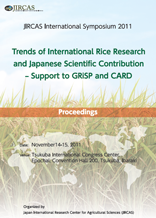High-yielding Technologies in China

Increasing crop yield is a major challenge for modern agriculture. In China hybrid rice has contributed greatly
to the self-sufficiency of food supply. To meet the future demand for rice production, a series of national
programs on super-rice breeding, functional genomics and GM breeding have been established in China since
1996. We have cloned some important high yield-related genes, IPA1 (Ideal Plant Architecture 1),
DEP1(dense and erect panicle 1), GIF1(grain-filling 1), Ghd7(grain weight, plant height and heading date)
and GW2(grain width 2). The development of new plant type of IPA, has been proposed as a means to
enhance rice yield potential over that of existing high-yield varieties. IPA1, a semidominant quantitative trait
locus, profoundly changes rice plant architecture and substantially enhances rice grain yield. IPA1 encodes
OsSPL14 (SOUAMOSA PROMOTER BINDING PROTEIN-LIKE 14) and is regulated by microRNA
(miRNA) OsmiR156 in vivo. We demonstrate that a point mutation in OsSPL14 perturbs OsmiR156-directed
regulation of OsSPL14, generating an ‘ideal’ rice plant with a reduced tiller number, increased lodging
resistance and enhanced grain yield. So these yield genes have been used in super-rice and GM breeding to
improve rice grain yield. Actual yield of a japonica rice variety XS11-ipa1 could increase 10% over its CK
XS11.
| 刊行年月日 | |
|---|---|
| 作成者 | Qian Qian |
| 著者キーワード |
rice yield IPA1 gene cloning super-rice breeding |
| 公開者 | Japan International Research Center for Agricultural Sciences |
| オンライン掲載日 | |
| 号 | 2011 |
| 開始ページ | 137 |
| 終了ページ | 145 |
| 権利 | Japan International Research Center for Agricultural Sciences |
| 言語 | eng |
